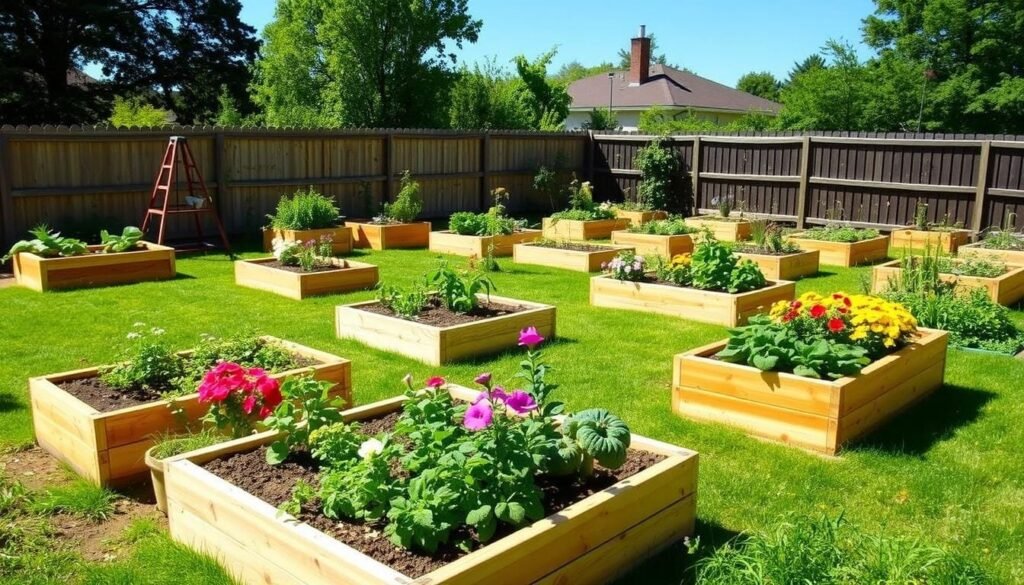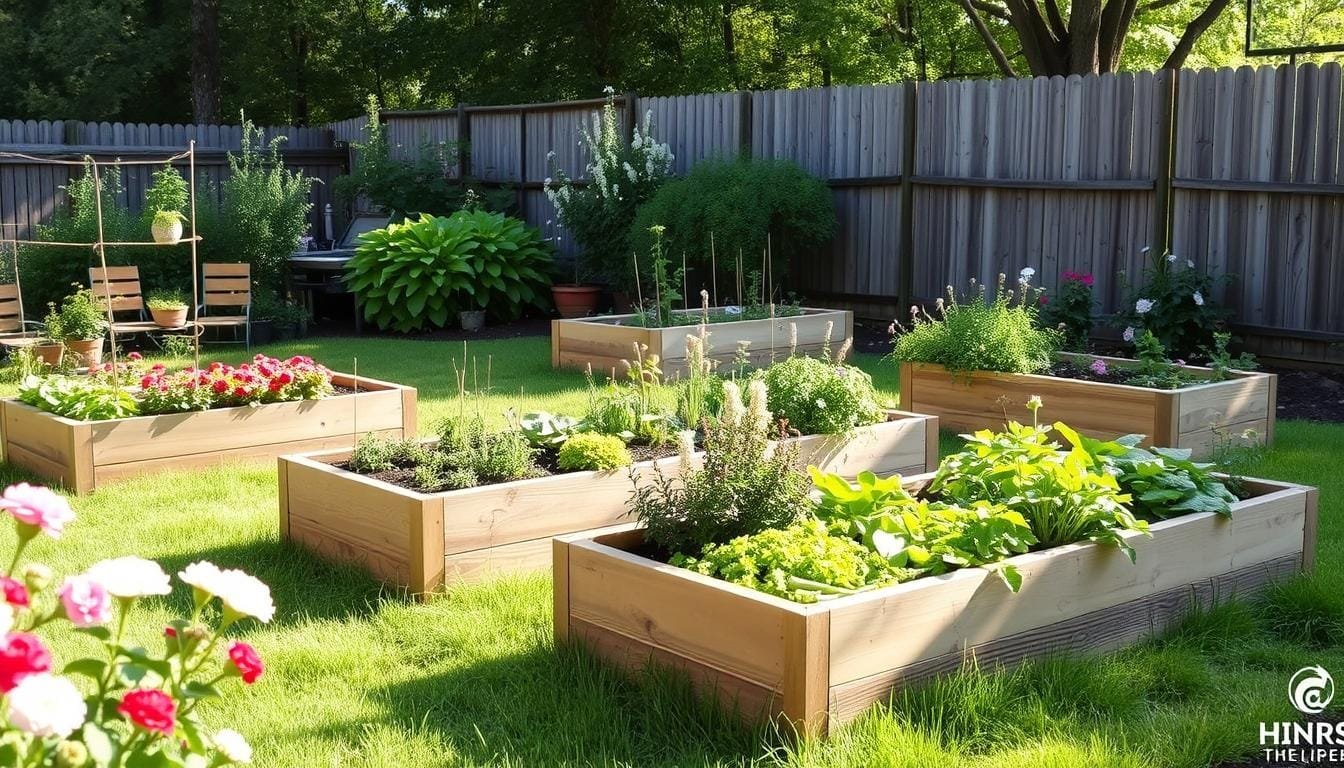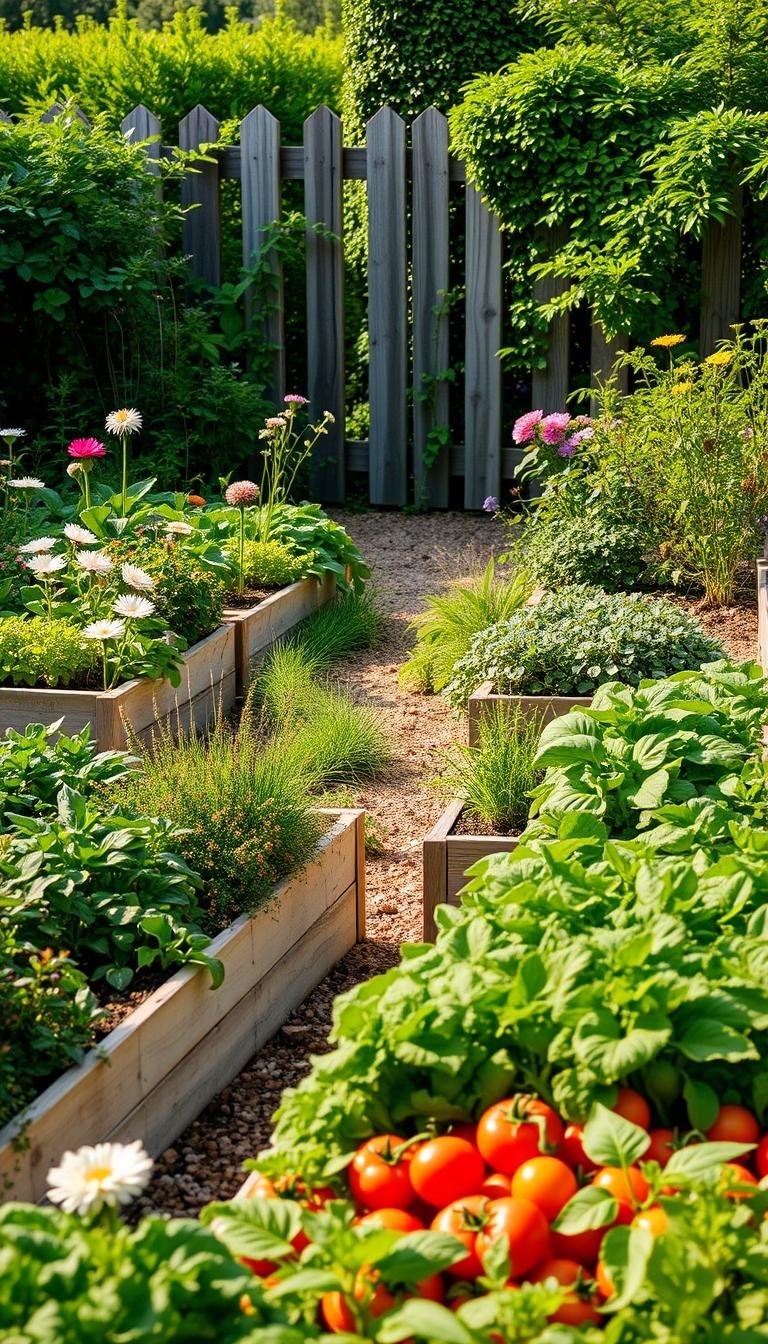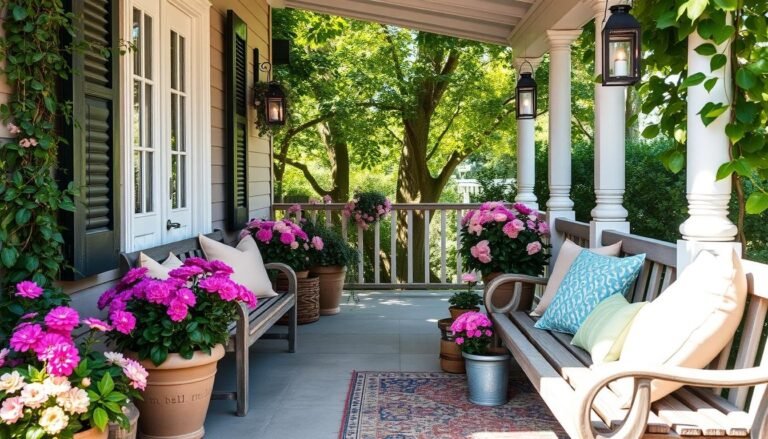This post may contain affiliate links. If you click and buy, we may earn a small commission at no extra cost to you. Learn more.
Building your own raised garden beds is a fun and useful project for gardeners of all levels. Raised beds improve soil quality, make gardening easier, and help control pests. They’re perfect for growing lots of veggies or a variety of flowers, turning your backyard into a lush paradise.
Raised garden beds are elevated areas for plants, made from wood, metal, or stone. They keep the soil separate from the ground. This design boosts plant health and makes gardening more enjoyable.
Contents
- 1 Benefits of DIY Raised Garden Beds
- 2 Choosing the Right Location
- 3 Materials Needed for Construction
- 4 Planning Your Garden Bed Size
- 5 Preparing Your Site
- 6 Step-by-Step Construction Guide
- 7 Soil Mixture for Raised Beds
- 8 Planting Strategies for Success
- 9 Watering Techniques for Raised Beds
- 10 Maintaining Your Raised Garden Beds
- 11 Common Mistakes to Avoid
- 12 Conclusion: Enjoying Your Garden Oasis
Key Takeaways
- Raised garden beds offer improved soil drainage, easier access, and protection from pests
- DIY raised beds allow you to customize the size and shape to fit your available space
- Choosing the right location, materials, and soil mixture are crucial for successful raised bed gardening
- Step-by-step construction and planting strategies can help you create a thriving backyard oasis
- Proper maintenance and attention to common mistakes can ensure your raised beds flourish
Benefits of DIY Raised Garden Beds
Gardening fans know the perks of raised bed gardening. These DIY beds can turn your backyard into a lush spot for fresh food and colorful flowers.
Improved Soil Drainage
Raised beds help with soil drainage. They keep water away from roots, stopping waterlogging. This ensures plants get the right moisture for growth. It’s great for areas with heavy clay or poor drainage.
Easier Access for Gardening
Raised beds make gardening easier. They bring your garden closer, reducing back and joint strain. This makes planting, weeding, and harvesting more comfortable.
Protection from Pests
Raised beds act as a pest barrier. They keep out burrowing animals and insects. This makes it harder for pests to reach your plants, protecting your garden.
Extended Growing Season
Raised beds warm up faster, letting you start growing sooner. They also improve air circulation. This can delay frost in the fall, extending your growing season.
DIY raised garden beds can make your backyard a lush haven. They offer fresh produce and colorful blooms, all with the ease of this gardening method.
Choosing the Right Location
When you start with DIY raised garden beds, picking the right spot is key. It affects how well your garden grows. You need to think about sunlight and drainage to start your garden bed project.
Sunlight Requirements
Most veggies and herbs love full sun, needing at least 6 hours of direct sunlight daily. Look for areas that get the most sun. Stay away from shady spots or places with lots of trees, as they can slow down plant growth.
Drainage Considerations
- Good drainage is vital for your plants and the life of your raised garden beds.
- Find a spot with a gentle slope or natural drainage to let water flow away.
- Steer clear of low spots where water might collect, as it can cause soggy soil and root rot.
Proximity to Water Source
Having water nearby is important for your DIY raised garden beds. Place them near a hose or spigot for easy watering. This saves time and makes sure your plants get enough water to grow well.
“The right location can make all the difference in the success of your DIY raised garden beds.”
Materials Needed for Construction
Building your own DIY raised garden beds requires the right materials and tools. This ensures a successful project. We’ll cover the essentials needed for the perfect raised beds in your backyard.
Wood Options for Raised Beds
Wood is the most common choice for raised garden beds. Here are some popular options:
- Cedar – A naturally weather-resistant wood perfect for outdoor projects.
- Redwood – Durable and long-lasting, great for withstanding the elements.
- Pressure-treated lumber – A cost-effective option, but check if it’s safe for food gardening.
Alternative Materials: Metal and Stone
Wood is classic, but you can also consider other materials for your garden bed construction. Here are a few:
- Metal – Galvanized steel or aluminum for sturdy, modern raised beds.
- Stone – Masonry blocks, bricks, or natural stones for a rustic look in your DIY raised garden beds.
Tools You’ll Need
To create your raised bed vision, you’ll need some essential tools:
- Saw (hand saw, power saw, or miter saw)
- Drill and drill bits
- Measuring tape
- Level
- Hammer
- Screws or nails
With the right materials and tools, you’re ready to build the perfect raised garden beds. Choose what fits your budget, style, and gardening needs.

Planning Your Garden Bed Size
Getting the size right is crucial for a successful raised garden bed. It’s important for maximizing space and getting a good harvest. Whether you’re new to gardening or have experience, knowing the standard sizes and customization options is key. This will help you create the perfect vegetable garden beds for your backyard.
Standard Dimensions
Most raised garden beds are 4 feet by 4 feet or 4 feet by 8 feet. These sizes are great for growing many vegetables, herbs, and flowers. But, the best size for you depends on your backyard space and what you like.
Custom Sizes for Your Space
You can make raised garden beds any size you need. Think about your backyard’s layout and your gardening goals. The goal is to use your space well but still be able to reach and care for your plants.
Height Considerations
The height of your raised garden beds matters too. Taller beds, 18 to 24 inches, are good for better drainage and for those with mobility issues. Shorter beds, around 12 inches, are better for easier access. Choose a height that works for you and your gardening style.
“The great thing about raised garden beds is that you can customize them to fit your specific needs and space.”
Preparing Your Site
Starting a garden bed requires good site preparation. Before you start making your DIY raised garden beds, clear the area, level the ground, and add landscaping fabric. This creates a strong base for your backyard garden.
Clearing the Area
First, remove any grass or weeds from the garden bed area. This stops them from competing with your plants. Use a spade or hoe to remove the unwanted plants, leaving a clean space for your garden bed construction.
Leveling the Ground
After clearing, level the ground. This is key for a stable and even surface for your DIY raised garden beds. Use a rake or hand tamper to even out any bumps, making the ground flat for the next steps.
Adding Landscaping Fabric
To keep weeds out, lay down landscaping fabric. This material blocks sunlight and weeds, letting your plants grow well. Secure the fabric and cut holes for planting directly into the bed.
By preparing your site well, you’ll have a strong base for your DIY raised garden beds. This sets you up for a successful and easy gardening experience.
Step-by-Step Construction Guide
Building your own DIY raised garden beds is rewarding and satisfying. It’s easy, whether you’re experienced or new to gardening. Here’s a simple guide to making sturdy and useful garden bed frames.
Building the Frame
The first step is the frame. Measure and cut the wood to fit your garden bed size. Use durable wood like cedar or treated pine for lasting results. Place the wood on a flat surface and screw or nail them together to form a rectangular frame.
Securing the Structure
After building the frame, secure it in place. Place the frame where you want it and make sure it’s level. Use a spirit level or straightedge to check. If needed, adjust the frame by adding or removing soil until it’s perfectly level.
Installing Corner Braces
- Cut additional wood for corner braces.
- Attach the corner braces inside the frame with screws or nails.
- These braces add stability and prevent the frame from warping over time.
Always check the frame’s alignment and levelness as you build. This care ensures your DIY raised garden beds will be strong and ready for a lush backyard oasis.

Soil Mixture for Raised Beds
Quality soil is key for a successful raised bed garden. It’s the base for healthy, growing plants. We’ll cover how to make the best soil mix for your garden beds.
Choosing Quality Soil
Start by picking a top-notch soil mix. Look for one that’s full of nutrients, drains well, and is weed-free. Choose a mix made for raised beds or vegetable gardens. These are designed for the best plant growth.
Recommended Soil Ratios
For your own mix, aim for this ratio:
- 40% high-quality topsoil
- 40% compost or well-rotted organic matter
- 20% vermiculite or perlite for better drainage and air
Benefits of Compost
Compost is a game-changer for your soil. It adds vital nutrients, holds moisture, and supports good microbes. Adding lots of compost will help your garden grow strong and fruitful.
“Healthy soil is the key to a bountiful raised garden. Take the time to get your soil mixture just right, and you’ll be rewarded with a robust, vibrant harvest.”
Planting Strategies for Success
Right planting strategies are key for a thriving vegetable garden. Raised bed gardening offers several techniques for better yields and healthier plants.
Companion Planting
Companion planting is a crucial strategy in raised bed gardening. It involves choosing plants that work well together. For instance, marigolds can keep pests away from tomatoes. Basil and tomatoes also make great pairs, boosting each other’s flavors.
Crop Rotation Basics
Crop rotation is another smart move for raised bed gardening. It involves moving different plants around to avoid disease and pests. This keeps the soil balanced and healthy.
Seasonal Planting Tips
- Start with cool-weather crops like lettuce, spinach, and radishes in early spring.
- Switch to warm-weather veggies like tomatoes, peppers, and zucchini when it gets warmer.
- Use cold-tolerant plants in the fall to keep harvesting.
By using these strategies, your raised bed garden will flourish. You’ll enjoy a rich harvest all year round.
Watering Techniques for Raised Beds
Keeping the right moisture levels is key for a successful raised bed garden. Good watering techniques can greatly improve your plants’ health and growth.
Drip Irrigation Systems
Think about getting a drip irrigation system for your raised beds. It sends water straight to the roots, cutting down on evaporation. This method is great for saving water and keeping the soil moist.
Watering Frequency
How often to water your raised beds depends on several things. These include the weather, soil type, and what your plants need. Generally, water them 1-2 times a week, giving about 1-2 inches of water each time. You might need to change this based on the weather and how your plants are growing.
Mulching Benefits
- Adding a 2-4 inch layer of organic mulch, like wood chips or straw, helps keep moisture in your raised beds.
- Mulch slows down evaporation, keeping the soil from drying out too fast.
- It also keeps weeds away, which can take water and nutrients from your plants.
Using these watering methods will help your raised bed garden or container garden stay healthy and water-efficient.

Maintaining Your Raised Garden Beds
Keeping your DIY raised bed garden healthy is crucial. It involves regular cleaning, managing pests, and adding nutrients. These steps will help you enjoy a rich harvest. Let’s look at how to maintain your garden.
Seasonal Cleanup
Seasons bring changes to your raised beds. In spring, clear out dead plants, weeds, and debris. This makes room for new growth. In fall, trim back perennials, add compost, and mulch to protect the soil.
Pest Management Tips
- Use organic pest control like beneficial insects, neem oil, or row covers.
- Check your beds often for pests and deal with them quickly.
- Try companion planting with herbs and flowers to keep pests away.
Nutrient Management
- Add 2-4 inches of compost or aged manure to your beds each year.
- Check your soil’s pH and adjust it for your plants.
- Try natural fertilizers like fish emulsion or seaweed for nutrients.
By following these maintenance tips, your raised bed garden will flourish. A little effort will lead to a thriving raised bed gardening space in your yard.
Common Mistakes to Avoid
Building DIY raised garden beds can be rewarding. But, knowing common mistakes is key to success. Here are three areas where gardeners often go wrong and how to fix them.
Poor Soil Choices
Soil quality is vital in raised bed gardening. Cheap soil can harm plant growth and reduce harvests. Choose a high-quality mix for your beds. It should have compost, topsoil, and other nutrients for your plants.
Overcrowding Plants
It’s easy to want to fill your beds with plants. But, overcrowding hurts plant growth and harvests. Use the right spacing to let your plants grow well.
Neglecting Drainage
Good drainage is essential for your garden’s health. Stagnant water can cause root rot and harm plants. Make sure your beds drain well by using gravel or landscape fabric.
Avoiding these mistakes will help your DIY raised garden beds and raised bed gardening thrive. With careful planning, your garden will flourish. Enjoy fresh produce and the satisfaction of gardening at home.
Conclusion: Enjoying Your Garden Oasis
Reflect on the joy of creating your DIY raised garden beds. From planning to nurturing your garden, every step was rewarding. You’ve built something special.
Reflecting on Your Gardening Journey
Gardening is more than just the end result. It’s about the journey, growth, and connection with nature. You’ve learned to care for the soil and watch your plants grow. Your garden has become a source of joy.
Community Gardening Ideas
Think about sharing your gardening skills with your community. Start a community garden with neighbors and friends. It’s a way to unite and create a shared green space.
Inspiring Others with Your Creation
Your garden is not just for food and joy. It shows the power of gardening. Share your story and inspire others to garden. You might start a new gardening movement.
To bring you cozy inspiration more efficiently, we sometimes use AI to assist in content creation — but every word and idea is carefully shaped by our team. See our AI Disclosure for more info.







